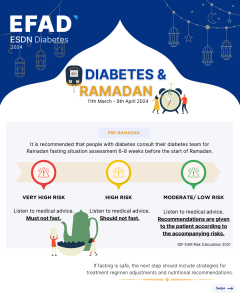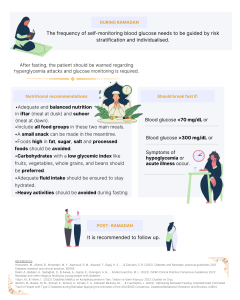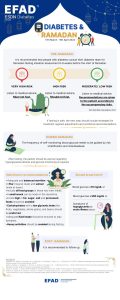In light of the sacred month of Ramadan, from March 11th to April 9th, EFAD’s ESDN Diabetes announces the release of an insightful infographic. Tailored to address the intersection of diabetes management and Ramadan observance, this resource marks a significant stride in promoting cultural sensitivity and community support within the healthcare sector.
The infographic, meticulously curated by ESDN Diabetes, not only highlights the crucial dates of Ramadan but also delves into practical guidelines designed to assist dietitians and healthcare professionals in providing optimal care to individuals with diabetes during this sacred period.
As Ramadan approaches, EFAD’s ESDN Diabetes invites healthcare practitioners, researchers, and individuals alike to access and share this invaluable resource that you can find below available in two formats: a downloadable PDF file for printing or as Social Media assets that you can easily share in your channels, tagging @efad (resharing is allowed, only if the original version is kept).
Pre – Ramadan
It is recommended that people with Diabetes consult their diabetes team (doctor, dietitian, nurse) for Ramadan fasting situation assessment 6-8 weeks before the start of Ramadan. Risk stratification is recommended for risk assessment (high risk of acute complications such as hypoglycemia, hyperglycemia, dehydration and diabetic ketoacidosis) ‘The International Diabetes Federation (IDF) and the Diabetes and Ramadan (DAR) International Alliance risk calculation (2021)’.
- Category 1: (very high risk) listen to medical advice must not fast,
- Category 2: (high risk) Listen to medical advice should not fast,
- Category 3: (moderate/low risk) Listen to medical advice, recommendations are given to the patient according to the accompanying risks.
If fasting is safe, the next step should include strategies for treatment regimen adjustments and nutritional recommendations.
During Ramadan
The frequency of self-monitoring blood glucose needs to be guided by risk stratification and individualised.
After fasting, the patient should be warned regarding hyperglycemia attacks and glucose monitoring is required. All induviduals with diabetes should break their fast if blood glucose <70 mg/dL or > 300 mg/dL or symptoms of hypoglycemia or acute illness occur.
Adequate and balanced nutrition should be provided in iftar (meal at dusk) and suhoor (meal at dawn), and care should be taken to include all food groups in these two main meals. If possible, a small snack can be made in the meantime. Foods high in fat, sugar, salt and processed foods should be avoided. Carbohydrates with a low glycemic index like fruits, vegetables, whole grains, and beans should be preferred. Adequate fluid intake should be ensured to stay hydrated. Heavy activities should be avoided during fasting. A personalized nutrition program should be planned before Ramadan fasting by a Diabetes Dietitian.
Post – Ramadan
It is recommended to follow up.
REFERENCES
Hassanein, M., Afandi, B., Ahmedani, M. Y., Alamoudi, R. M., Alawadi, F., Bajaj, H. S., … & Zainudin, S. B. (2022). Diabetes and Ramadan: practical guidelines 2021. Diabetes research and clinical practice, 109185.
Deeb, A., Babiker, A., Sedaghat, S., El Awwa, A., Gupta, K., Pulungan, A. B., … & Marcovecchio, M. L. (2022). ISPAD Clinical Practice Consensus Guidelines 2022: Ramadan and other religious fasting by young people with diabetes.
Yalçın, M., & Yetkin, İ. (2022). Diabetes Mellitus ve Komplikasyonlarının Tanı, Tedavi ve İzlem Kılavuzu-2022: Diyabet ve Oruç
Ibrahim, M., Barker, M. M., Ahmad, E., Ahmed, A., Annabi, F. A., Ebtesam Ba‐Essa, M., … & Tuomilehto, J. (2022). Optimizing Ramadan Fasting. A Randomised Controlled Trial for People with Type 2 Diabetes during Ramadan Applying the principles of the ADA/EASD Consensus. Diabetes/Metabolism Research and Reviews, e3604.



